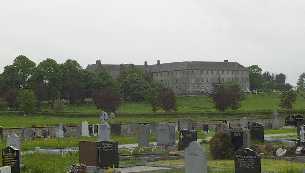
© View of Mungret College from Mungret graveyard
In the Catholic Directory of 1837, Mungret parish is referred
to as Loghmore. In the same year the parish name was changed to Mungret.
According to Lewis, the civil parish of Loghmore comprised of Crecora,
Mungret, Knocknagall and part of Kilpeacon, with chapels in Crecora
and Mungret.
The name Mungret is supposedly derived from the Irish
Muine Gairid, meaning 'the Short Hill', or 'the Short Thicket
or Grove', although according to 'Limerick, the Rich Land', this definition
was a guess by John O'Donovan in 1840. Other Irish forms of the name
are Imungram and Moungairid.
Crecora is derived from the Irish Craobh Comhartha,
which means 'the sweet scented branch' or 'the tree of the sign'. According
to local tradition, a whitethorn bush was growing 300 yards north east
of the old church. Pilgrims used to hang signs or tokens from the branches.
The old church took its name from this bush.
A diocesan college was opened in Mungret in 1878, and
was later taken over by the Jesuits.
Extensive ruins of an early Christian monastery exist
in Mungret graveyard. Mungret College overlooks these ruins. The monastery
is said to have been founded by St Nessan, who was abbot of Mungret
in the 6th century
The bell of Mungret was dug up at Loghmore near the abbey.


Website by Lúnasa
Design